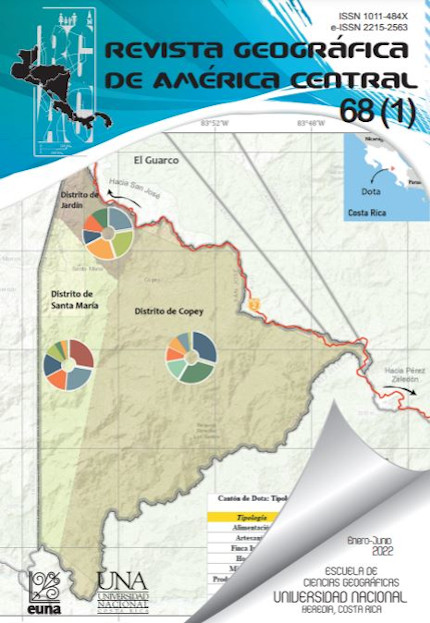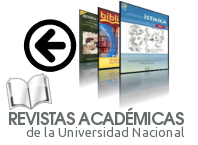Mining environmental liabilities: a potential source of metal contamination for freshwater ecosystems in Costa Rica
DOI:
https://doi.org/10.15359/rgac.68-1.12Keywords:
handling, leachate, metal, mining, liabilitiesAbstract
Metal mining in Costa Rica, and use of toxic substances in this activity, has occasionally resulted in the negligent abandonment of waste structures containing significant amounts of toxic metals. These structures have been exposed to oxidation and weathering, resulting in the environmental release of metals, thus affecting the quality of the surrounding freshwater ecosystems. The objective of the investigation was to determine to what extent the abandoned mining liabilities in Líbano de Tilarán, Guanacaste, are a potential source of metal contamination for the waters, sediments and benthic macroinvertebrates of the San José and Cañas Rivers. The possible consequences for the environment associated with the presence of mining wastes were quantitatively and qualitatively assessed through the amounts of metals present in the wastes and leachate. Infiltration tests were carried out and a wet cell kinetic test allowed describing the processes and chemical reactions that are likely to occur in mining wastes during rain, associated with the loading of metals in leachate. The presence of pyrite (FeS2), which favors the acidification of the medium and the release of metals, was shown by X-ray diffraction tests on samples of the waste materials. The results show a high content of metals (37.8 tons of lead, 20.2 tons of arsenic and 0.4 tons of cadmium) from the total of ~106 000 tons in mining liabilities, the solubilization of these and other metals in an oxidizing acid medium (pH: 4.16, EC: 3620 µs / cm and ORP: 275 mV) during the dry-rainy season transition and an important load of metals (277 kg / month of zinc, 234 kg / month of magnesium, 165 kg / month of aluminum, 96.1 kg / month of iron, 2.68 kg / month of cadmium, 0.90 kg / month of arsenic and 0.22 kg / month of lead) in leachates arriving to the San José River in September. This investigation showed that the abandoned mining liabilities in Líbano are a potential source of metal contamination for the surrounding freshwater ecosystems.
References
Arce, R. (2004). Resumen Diagnóstico Cuenca Cañas-Lajas. Cañas, Guanacaste: Proyecto Redes Comunitarias para la Gestión del Riesgo en Costa Rica.
APHA. (1995). Standard Methods for the Examination of Water and Wastewater (19 ed). American Public Health Association/American Water Works Association/Water Environment Federation, Washington, DC.
APHA. (2005) Standard Methods for the Examination of Water and Wastewater (21 ed.). American Public Health Association/American Water Works Association/Water Environment Federation, Washington DC.
Belzile, N., Chen, Yu-Wei, C., Mei-Fang, C. & Yuerong, L. (2004). A review of pyrrhotite oxidation. Geochemical Exploration, 84 (2), 65-75. doi: 10.1016/j.gexplo.2004.03.003
Camprubí, A., González-Partida, E. & Levresse, G. (2003). Depósitos Epitermales de alta y baja sulfuración: una tabla comparativa. Boletín de la Sociedad Geológica Mexicana, 56(1), 10-18.
Canadian Council of Ministers of the Environment (CCME). 2014. Canadian Soil Quality Guidelines for the Protection of Environmental and Human Health.
Candeias,C., Ferreira da Silva,E., Salgueiro, A.R., Pereira, H.G., Reis, A.P., Patinha, C., Matos, J.X. & Ávila, P.H. (2011). Assessment of soil contamination by potentially toxic elements in the aljustrel mining area in order to implement soil reclamation strategies. Land Degradation & Development, (22), 565–585. doi: 10.1002/ldr.1035
Castillo, M. R. (1997). Recursos minerales de Costa Rica: génesis, distribución y potencial. San José, Costa Rica: Editorial de la Universidad de Costa Rica, 58. Retrieved from: https://www.academia.edu/28107421/RECURSOS_MINERALES_DE_COSTA_RICA_-_ROLANDO_CASTILLO_MUNOZ
Chen, L. & W.A. Dick. (2011). Gypsum as an agricultural amendment: General use guidelines. The Ohio State University Extension, Columbus. Retrieved from: https://fabe.osu.edu/sites/fabe/files/imce/files/Soybean/Gypsum%20Bulletin.pdf
Cooke, D. (1987). Ore potential of the Compañía Minera Esperanza Property, Guanacaste province, Costa Rica: D.L. Cooke and Associates Ltd., Technical Report, 5.
Corrales, P. D & Martín, R. F. (2013). Evaluación de la peligrosidad de jales de zonas mineras de Nicaragua y México y alternativas de solución. Boletín de la Sociedad Geológica Mexicana, 65(3), 427-446.
Craw, D. (2000). Water–rock interaction and acid neutralization in a large schist debris dam, Otago, New Zealand. Chemical Geology, 171(1-2), 17–32. doi: 10.1016/S0009-2541(00)00231-X
González, S. M.R., Sánchez, T.S.A., Márquez, H. C., Lizárraga, M. L.G & Durán, D. M.C. (2008). Oxidación de Jales ricos en pirita en un reactor a escala de banco. Revista Latinoamericana de Recursos Naturales, 4 (2) ,130-138.
International Centre for Diffraction Data. (1997). Powder Diffraction File Sets 1-47.
Instituto Costarricense de Electricidad (ICE). (2015). Estación meteorológica Líbano (1984 al 2015), Centro de Servicios Estudios Básicos de Ingeniería - Área de Hidrología.
Instituto Meteorológico de Costa Rica (IMC). (2010). Mapa, CAPA estado actual del tiempo. Retrieved from: https://www.imn.ac.cr/
Jambor, J.L. (1994). Mineralogy of sulfide-rich tailings and their oxidation products. In: J. L. Lambor, & D. W. Blowes. (Eds.). The environmental geochemistry of sulfide mine-wastes. Mineralogical Association of Canada, Short Course Handbook, 22,103-132.
Jarup, L. (2003). Hazards of heavy metal contamination. Brithis Medical Bulletin, 68(1), 167-182. doi: 10.1093/bmb/ldg032
Kyungmin, K., Juhee, K. & Seunghun, H. (2018). Soil attenuation of the leaching potential of mine-related metallic elements (Zn, As, and Cd) under different leachate solute compositions. Environmental Management, 222, 402–408. doi: 10.1016/j.jenvman.2018.05.096
Langmuir, D. (1997). Aqueous Environmental Geochemistry. New Jersey: Prentice-Hall.
Naicker, K., Cukrowska, E. & McCarthy,T. S. (2003). Acid mine drainage arising from
gold mining activity in Johannesburg, South Africa and environs. Environmental Pollution, 122(1), 29-40. doi: 10.1016/s0269-7491(02)00281-6
Navarro, M.C., Pérez-Sirvent, C., Martínez-Sanchez, M.J., Vidal, J., Tovar, P.J., & Bech, J. (2008). Abandoned mine sites as a source of contamination by heavy metals: A case study in a semi-arid zone. Geochemical Exploration, 96(2–3), 183-193. doi: 10.1016/j.gexplo.2007.04.011
Nicholson, R.V. (1994). Iron-sulfide oxidation mechanisms: laboratory studies. In D. W. Blowes & J. L. Jambor. (Eds.). The Environmental Geochemistry of Sulfide Mine Wastes (163-183). Mineralogical Association of Canada, Ontario.
Roldán, G. y Ramírez, J. J., (2008). Fundamentos de Limnología Neotropical. Medellín: Universidad de Antioquia.
Ritchie, A. I. (1994). Sulfide oxidation mechanisms: controls and rates of oxygen transport. In D. W. Blowes & J. L. Jambor. (Eds.). Environmental Geochemistry of Sulfide Mine Wastes (201-245). Mineralogical Association of Canada, Ontario.
Plumlee, G.S. & Nash, J.T. (1995). “Geoenvironmental models of mineral deposits; fundamentals and applications”. In E. A. du Bray. (Ed.). Preliminary Descriptive Geoenvironmental Models of Mineral Deposits. U.S. Geological Survey, Open-File Report, 1–9.
Plumlee, G.S. (1999). The environmental geology of mineral deposits. In G. S. Plumlee & M. J. Logsdon. (Eds.), The Environmental Geochemistry of Mineral Deposits, Part A: Processes, Techniques, and Health Issues: Economic Geology, v. 6A, 71-116.
Pruvot, C., Douay, F., Hervé, F. & Waterlot, C. (2006). Heavy Metals in Soil, Crops and Grass as a Source of Human Exposure in the Former Mining Areas. Soils and Sediments, 6, 215–220. doi: 10.1065/jss2006.10.186
Robertson, W.D. (1994). The physical hydrology of mill-tailings impoundments. In D. W. Blowes & J. L. Jambor. (Eds.). Environmental Geochemistry of Sulfide Mine Wastes (1-17). Mineralogical Association of Canada, Ontario.
Rösner, T. & Van Schalkwyk, A. (2000). The environmental impact of gold mine tailings footprints in the Johannesburg region, South Africa. Bulletin of Engineering Geology and Environmental, 59: 137-148. doi: 10.1007/s100640000037
Rose, A. W., & Cravotta, C. A. (1998). III. Geochemistry of Coal Mine Drainage. In Coal Mine Drainage Prediction and Pollution Prevention in Pennsylvania. Pennsylvania: Department of Environmental Protection. Retrieved from: https://www.dep.state.pa.us/dep/deputate/minres/districts/CMDP/chap01.html.
Schosinsky, G. & Losilla, M. (2000). Modelo analítico para calcular la infiltración con base en la lluvia mensual. Revista Geológica de América Central, 23, 44-55.
Seal II, R. & Foley, N. K. (2002). Progress on Geoenvironmental Models for Selected Mineral Deposit Types. In P. L. Younger, S. A. Banwart & R. S. Hedin. (Eds.). Mine Water, Hydrology, Pollution y Remediation. Kluwer Academic Publishers. Bodmin, Cornwall, Reino Unido.
Seed, H., Tokimatsu, K., Harder, L. & Chung, R. (1985). Influence of SPT Procedures in Soil Liquefaction Resistance Evaluations. Geotechnical Engineering, ASCE, 111(12).
Singer, D.A., Norman J.P., Bagby, W.X., Cox, D.P & Ludington, S. (1990). Evaluación de los Recursos Minerales de Costa Rica. Revista Geológica América Central, 11, 1-25.
Singh, AN., Zeng, DH. & Chen, FS. (2005). Heavy metal concentrations in redeveloping soil of mine spoil under plantations of certain native woody species in a dry tropical environment, India. Environmental Sciences, 17(1), 168-174.
Sobek, A.A., W. A. Schuller, J.R. Freeman & R.M. Smith. (1978). Field and laboratory methods applicable to overburdens and mine soils. EPA-600/2-78-054. U.S. Environmental Protection Agency, Cincinnati, OH.
Triverdi, P. & Axe, L. 2000. Modelling Cd and Zn sorption to hydrous metal oxides. Environmental Science & Technology, 34(11), 2215-2223. doi: 10.1021/es991110c
Published
How to Cite
Issue
Section
License
Proposed policy for journals offering Open Access
Authors publishing their works in the Journal acknowledge and agree to the following terms:
a) Authors retain the copyrights to their works and guarantee the Journal the right to be the first to publish their works, under the Creative Commons License Attribution-NonCommercial-ShareAlike 4.0 International, CC BY-NC-SA 4.0 International (https://creativecommons.org/licenses/by-nc-sa/4.0/deed.es), which allows others to share works upon complying with the acknowledgment of authorship and mention of the Journal as the original publisher of the work.
b) Authors are permitted to separately establish additional agreements for the non-exclusive distribution of the official edition of the work published in the Journal (for example, authors may desire to place the work in an institutional repository or incorporate it into a book that is to published elsewhere) so long they acknowledgment to recognize the Journal as the original publisher. The aforementioned additional agreements must respect the terms of the non-profit character and sharing philosophy of the original license (CC BY-NC-SA 4.0 International, https://creativecommons.org/licenses/by-nc-sa/4.0/deed.es).
c) Authors are encouraged to archive the post-print or editor/PDF version in Open Access repositories.







 REVGEO is licensed under https://creativecommons.org/licenses/by-nc-sa/4.0/deed.es
REVGEO is licensed under https://creativecommons.org/licenses/by-nc-sa/4.0/deed.es
.svg_4.png)

_(1).png)
_(1)_(1)_(1)_1.png)
(2)(1)(1)(1).png)
